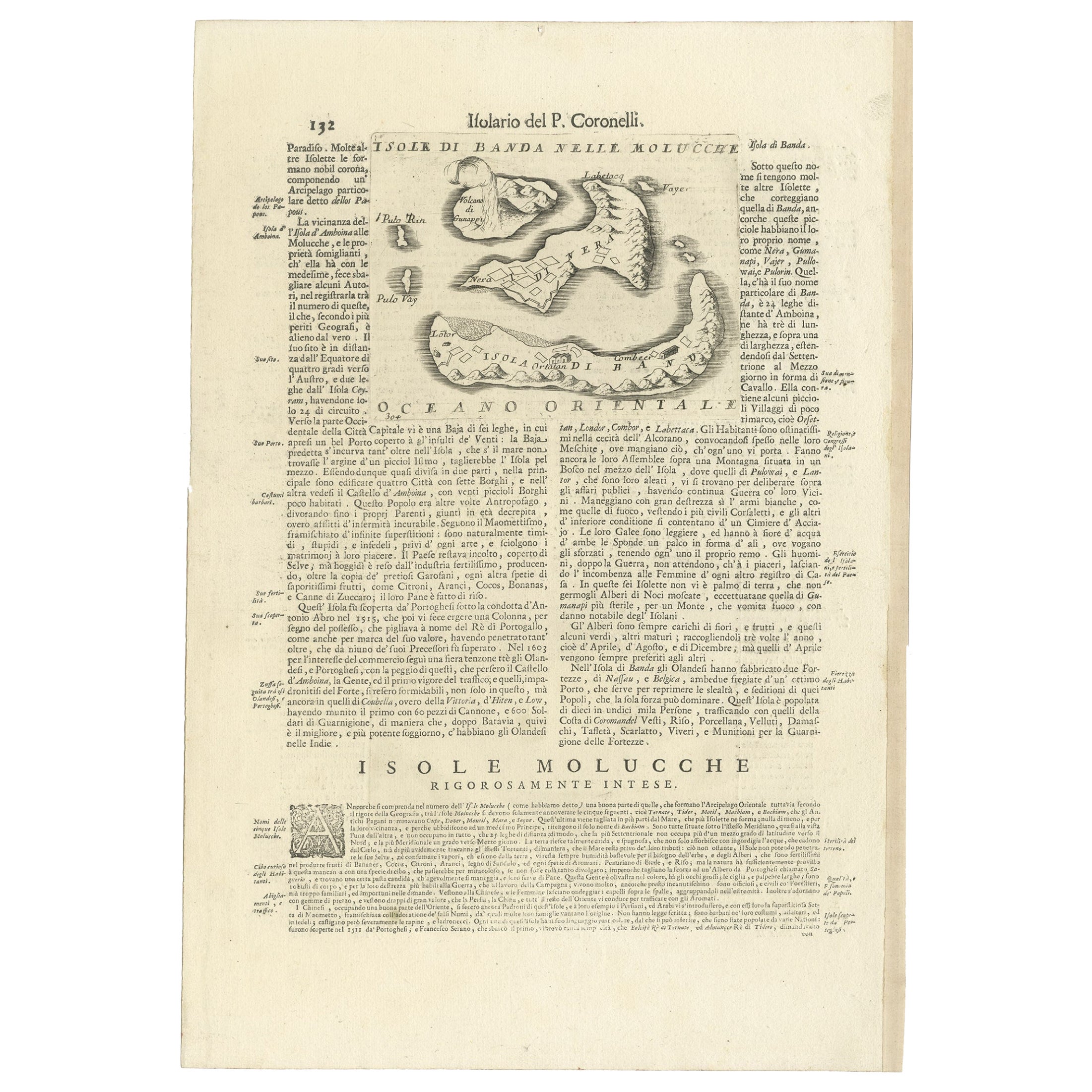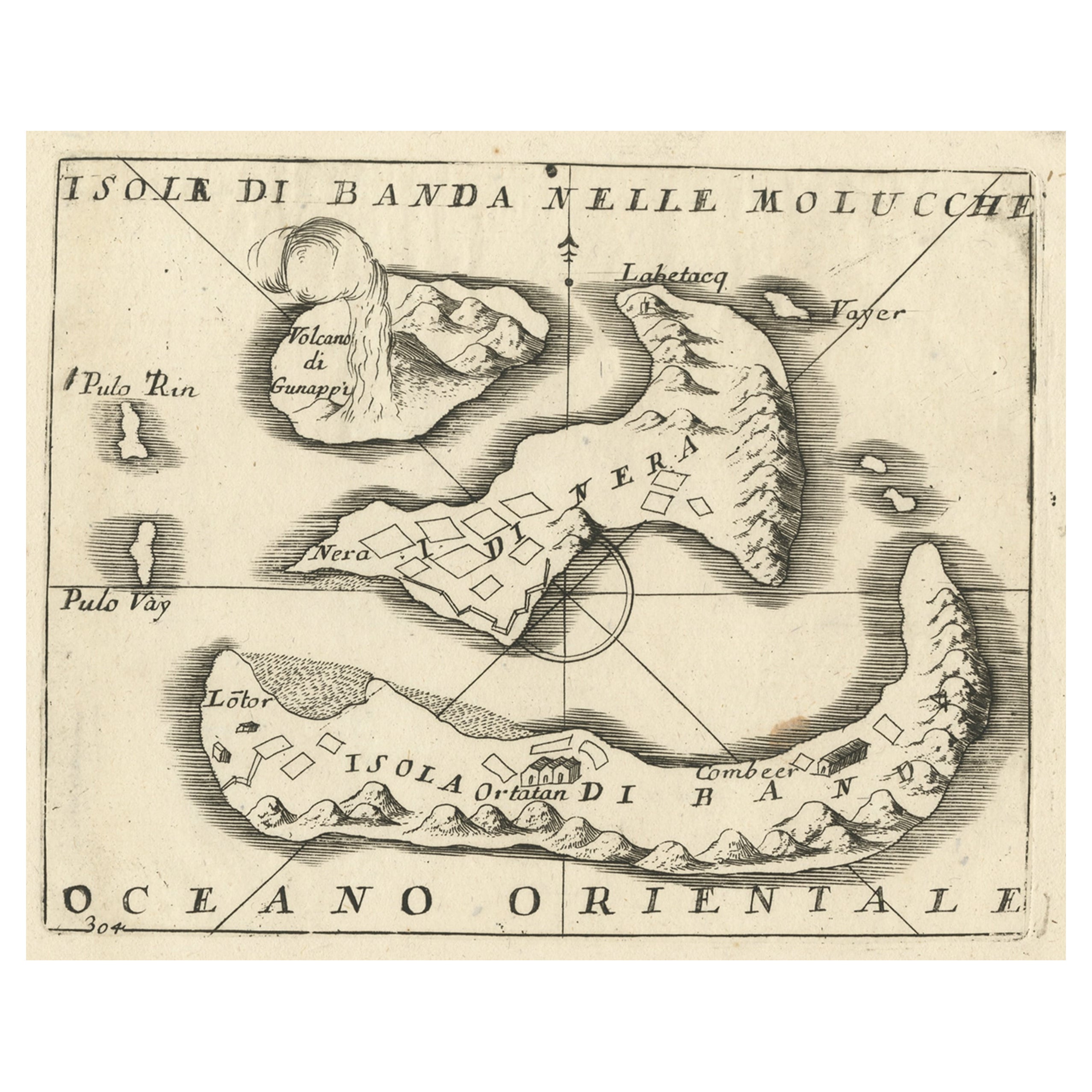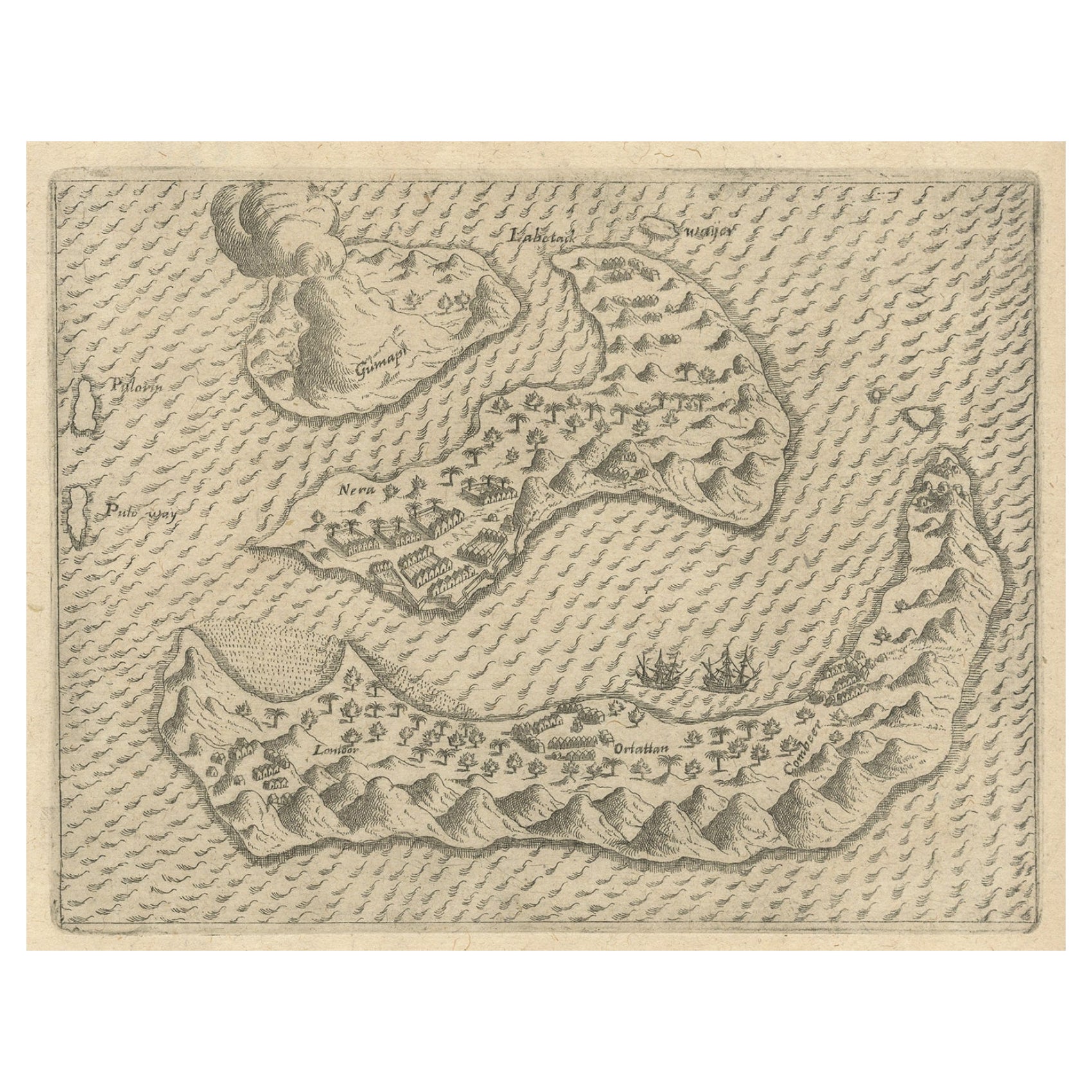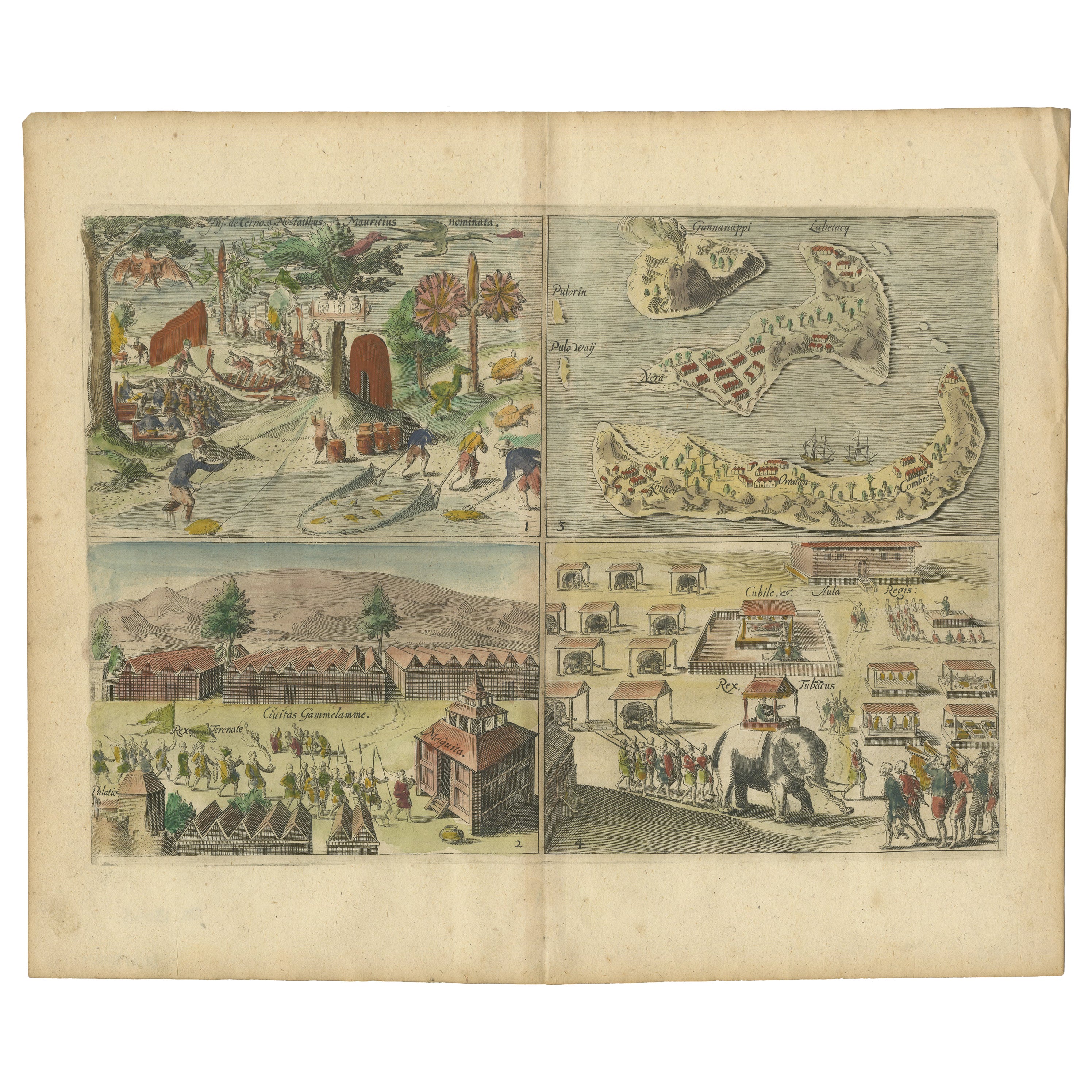Items Similar to Spice Epicenter: Engraving of The Banda Islands in the Age of Exploration, 1753
Want more images or videos?
Request additional images or videos from the seller
1 of 7
Spice Epicenter: Engraving of The Banda Islands in the Age of Exploration, 1753
About the Item
Title: Isles de Banda / Eylanden van Banda.
Maker: Van der Schley
Map of the Banda islands. Isles de Banda / Eylanden van Banda. Van der Schley based this chart on one contained in 'Het tvveede boeck, iournael oft dagh-register' by Jacob Cornelisz van Neck,.
This original antique engraving provides a detailed map of the Banda Islands, a group of ten small volcanic islands in the Banda Sea, central to the historic spice trade. The map showcases the islands' topography, with lush greenery and hilly terrain, hinting at the once-abundant presence of nutmeg and mace which were native to the islands.
Highlighted on the map is Fort Nassau, a significant Dutch fortress during the spice trade era, indicating its role in the defense and administration of the islands for controlling the valuable spice resources. The map's legend, probably in French, points to various landmarks, including the names of individual islands like Neira, and possibly mentions other smaller forts or points of interest.
The engraving's coloration is muted, with earthy tones for the land and a soft green for vegetation, suggesting the map's age and artistic style. The sea surrounding the islands is left mostly uncolored, drawing attention to the detailed coastline and the strategic positioning of the fortifications.
This map is not just a geographic depiction but also a historical document, revealing the extent of European colonization and its impact on the region. It would have been used for navigation and to assert territorial claims during a time when maps were as much political tools as they were aids to navigation.
The Banda Islands, historically known as the original and sole location for the production of nutmeg and mace, have a rich and tumultuous history marked by colonial ambitions and trade. The earliest European contact was made by the Portuguese in 1511, shortly after conquering Malacca, a major Asian trade hub. The Portuguese expedition, led by António de Abreu, used Malay pilots to navigate to Banda and established the first European contact with the islands in early 1512. The Bandanese were initially resistant to Portuguese attempts to control the trade and did not allow them to build a permanent fort or outpost on the islands.
The Dutch followed, with the Dutch East India Company (VOC) arriving in 1599, aiming to establish a monopoly over the lucrative spice trade. Dutch-Bandanese relations were fraught with tension and conflict. The Bandanese resisted Dutch control, leading to the Dutch conquest of the Banda Islands between 1609 and 1621, during which the Dutch used force and violence to subdue the local population. This resulted in the infamous Banda massacre, where thousands of Bandanese were killed or enslaved, and the remaining population was expelled. The VOC then established a plantation system on the islands, bringing in labor from other parts of Indonesia and beyond to work the nutmeg plantations, thus securing a Dutch monopoly on nutmeg production.
The Banda Islands were also the location of the first Dutch fort in the region, Fort Nassau, built to control the nutmeg trade. The islands changed hands several times through various treaties and conflicts between European powers, most notably in the Treaty of Breda in 1667 when the British exchanged the island of Run, part of the Banda archipelago, for New Amsterdam (now New York City) in North America with the Dutch.
Today, the Banda Islands are recognized for their rich biodiversity, both on land and in the surrounding Coral Triangle, which is renowned for its coral reefs and marine life diversity. The islands are also culturally significant, with traditions such as the Cakalele dance and the Kora-Kora boat races reflecting the islands' history and heritage. The Banda Islands' colonial buildings, forts, and remnants of the plantation system are a testament to their historical importance as a center of spice trade and colonial exploitation.
- Dimensions:Height: 11.03 in (28 cm)Width: 11.62 in (29.5 cm)Depth: 0 in (0.02 mm)
- Materials and Techniques:Paper,Engraved
- Period:1750-1759
- Date of Manufacture:circa 1753
- Condition:Very good .A few flattened folding lines. Later Hand-Coloring.
- Seller Location:Langweer, NL
- Reference Number:Seller: BG-13268-31stDibs: LU3054337747582
About the Seller
5.0
Platinum Seller
These expertly vetted sellers are 1stDibs' most experienced sellers and are rated highest by our customers.
Established in 2009
1stDibs seller since 2017
1,928 sales on 1stDibs
Typical response time: <1 hour
- ShippingRetrieving quote...Ships From: Langweer, Netherlands
- Return PolicyA return for this item may be initiated within 14 days of delivery.
More From This SellerView All
- Antique Chart of the Banda Islands or The Spice Islands, Indonesia, 1726Located in Langweer, NLAntique map titled 'Nieuwe Caart der Eylanden van Banda'. Beautiful chart of the Banda Islands including Banda Api, Banda Neira, Banda Besar, Pulau Hatta (Rosengain), Pulau Ai an...Category
Antique 1720s Maps
MaterialsPaper
- Antique Map of the Banda Islands or Spice Islands, Moluccas, Indonesia, 1697Located in Langweer, NLAntique map titled 'Isole di Banda Nelle Molucche'. Engraved map of Isola di Banda, Nelle, Molucche. On verso: 'Isola di Solor'. Artists and Engravers: Vincenzo Maria (Padre)...Category
Antique 17th Century Maps
MaterialsPaper
- Small Old Map Depicting the Banda Islands or the Spice Islands, Indonesia, 1706Located in Langweer, NLAntique map titled 'Isole di Banda Nelle Molucche'. Small old map depicting the Banda Islands, Indonesia. Artists and Engravers: Published by V.M. Coronelli in Venice, 1706.Category
Antique Early 1700s Maps
MaterialsPaper
- Rare Antique Pap Depicting the Banda Islands or Spice Islands, Indonesia, c.1600Located in Langweer, NLAntique map Indonesia titled 'Bandae Insulae designatio'. Antique map depicting the Banda Islands, Indonesia. With Latin text, blank verso. Orig...Category
Antique Early 1600s Maps
MaterialsPaper
- Original Antique Map Southeast of the Banda or Spice Islands, Indonesia, 1726Located in Langweer, NLAntique map titled 'Kaart van de Zuyd-Ooster Eylanden van Banda'. Map of the southeastern part of the Banda islands. This map originates from 'Oud en Nieuw Oost-Indiën' by F. Valen...Category
Antique 1720s Maps
MaterialsPaper
- Antique Engravings of Mauritius and Indonesia, incl de Banda Islands, c.1730Located in Langweer, NLTitle on page: "Ins. de Cerno a. Nostatibus Mauritius Nominata [on sheet with] Gunnanappi Labetacq [and] Civitas Gammelamme [and] Rex Tubatus", Le Clerc, Jean This sheet includes fo...Category
Antique 1730s Maps
MaterialsPaper
You May Also Like
- "The Masterpieces of Engraving"By Eugene Maxime ValléeLocated in Alessandria, PiemonteO/7821 - interesting French book that I saved from ruin: they are usually dismembered to make prints to sell individually. This one is intact, with its 24 printed plates. Nice to ...Category
Antique Mid-19th Century French Other Books
MaterialsPaper
- Vintage Exploration: Realms of the Persian Gulf, 1970, USSR, 1J141Located in Bordeaux, FREmbark on a journey of exploration with this vintage book titled "Княжества Персидского залива" (Realms of the Persian Gulf). Originating from Moscow in the USSR and dating back to 1...Category
Vintage 1970s Books
MaterialsPaper
- 1865 Chart of the Islands of MadeiraLocated in Norwell, MARare James Imray chart from 1865 titled "Chart of the Islands of Madeira, Porto Santo and Dezerea" drawn from the survey made by Captain Ate Vidal Royal Navy, London. Published by Ja...Category
Antique 1860s European Maps
MaterialsPaper
- Engraving of The Motor Yacht "All Alone"Located in Norwell, MAEngraving showing the steam yacht "All Alone" cruising through calm seas. Three yachtsmen are seen in the wheelhouse. Overall dimensions: 19" H x 28" W. Weight is 10 lbs.Category
Vintage 1930s Nautical Objects
MaterialsPaper
- “The Restaurant of the House of Representatives” Engraving by Harper's WeeklyLocated in Colorado Springs, COThis original wood engraving is titled “The Restaurant of the House of Representatives, Washington, DC.” It was published as a double-page image, in the August 12, 1893 issue of the famous 19th century newspaper Harper’s Weekly. The print was illustrated by Charles Stanley Reinhardt. The House Restaurant, a unique part of life in the Capitol, has been in the same location since the 1857 Capitol Expansion. Congressional members’ busy work schedule made the availability of food on site a necessity. But the restaurant also served as an informal meeting spot for members to continue conversations and deal making. This 1893 print illustrates the convivial atmosphere. Details including elegantly dressed tables...Category
Antique 1890s American Prints
MaterialsPaper
- 1967 World Exploration School MapLocated in Tarrytown, NYPull down world exploration map from 1967.Category
Vintage 1960s Maps
MaterialsPaper
Recently Viewed
View AllMore Ways To Browse
Map Of Lebanon
Bad Bentheim
Wenceslas Hollar
English County Maps By Blaeu
Von Meer
Minature Map
Anguilla Map
James Calvert Smith
Herefordshire Antique Map
Hertfordshire Antique Map
Antique Map Of Alabama
Australasia Antique Map
Huntingdonshire Antique Map
Moldova Antique Map
Montreal Map
Tennessee Map
Antique Furniture Perth Australia
Antique Maps Perth





